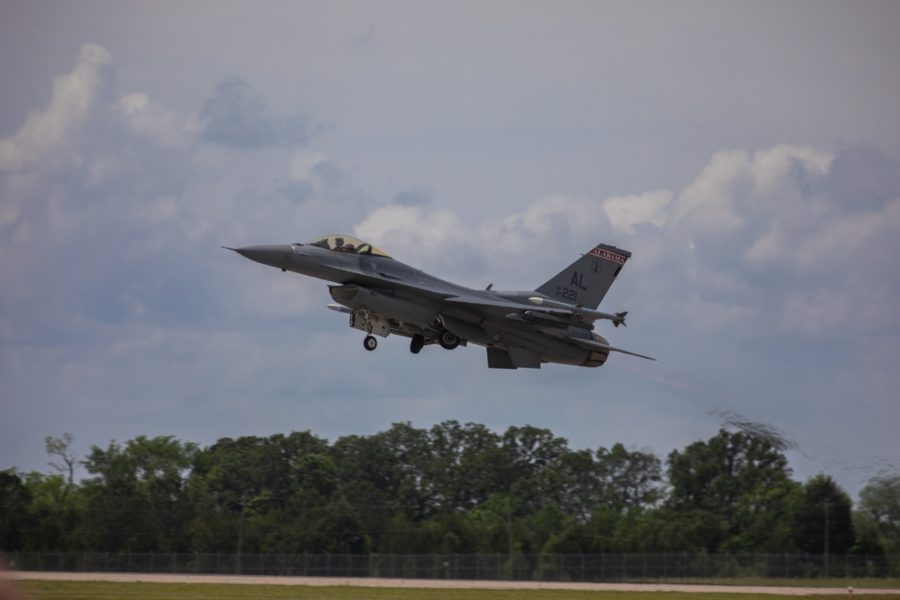The F-16s at Dannelly Field, Ala., are almost all gone, save for a few receiving final maintenance for their flights out. The F-35s the 187th Fighter Wing is bringing in won’t start to arrive until December.
But the next seven months will be anything but quiet for the Alabama Air National Guard’s 187th as it transitions to the fifth-generation fighter. The 187th began working on getting F-35s more than a decade ago, vice commander Col. Jay R. Spohn told Air & Space Forces Magazine. In 2017, Dannelly Field was tapped as one of two preferred Guard locations for F-35s, the other being Burlington Air National Guard Base, Vt. The 187th formally began its conversion March 1.
Yet in all that time, Spohn said, the wing kept its eyes on the present, not its future.
“The mantra from the leadership has always been, ‘We still need to do the mission in the F-16. We can’t take our eyes off of what’s really important. The F-35 is nice. We’re very fortunate that we’ve been selected for it … but our job here today is to get ready to go fight in the F-16,’” Spohn said.
That changed in the past few weeks, as the 187th conducted its final local training sorties in the F-16 on March 31, followed by a formal “farewell” ceremony April 21.
“There were people in that hangar two weeks ago saying goodbye to the F-16 that were here in this unit when the F-4s left in 1988, and they’re still in the unit today, when the F-16s are leaving,” Spohn said.
“We’re finally shifting to the mission we’ve been talking about for the last 10 years,” he added. “And it makes it a little simpler, I think, because now we don’t have to talk about two things at once. We can talk about one thing. We’re focused on one thing, one airplane. Your job is to be good at one thing, your job in the F-35.”
For pilots and maintainers, that means learning, including trips to bases already flying F-35s so they can train and get smart on their new aircraft.
The 187th has sent five pilots in recent years to train at Eglin Air Force Base, Fla., Hill Air Force Base, Utah, and Burlington to ensure the wing has seasoned Lightning II pilots when the first F-35s arrive. About 20 maintainers also went off for training. And more will soon in in the months ahead, Spohn said. Some nine pilots and 40 maintainers were off-station as he spoke.
“In December when the first three airplanes show up, we’ll have 15 pilots fully qualified in the airplane,” Spohn said. “And we’ll have 40-plus maintainers that will have several months or more time working on the F-35.”
That will still leave some pilots and maintainers who aren’t qualified—the pilots will all eventually have to spend three months with the F-35’s training units at either Eglin or Luke Air Force Base, Ariz., while the maintainers will be able to learn at Dannelly from their qualified counterparts and a field training team the Air Force will send.
But it’s not just the personnel who will work on and fly in the airplane who need several months to prepare for its arrival. The wing’s logistics and civil engineering specialists also have lots to do.
“We need to get all the F-16 stuff off base to make room for the F-35 support equipment,” Spohn said. “That’s everything from wheels and tires, screws, grease, O-rings, you name it. Everything you could think of walking through an auto parts store, there’s kind of the equivalent of that as you walk through our supply area for the F-16 and for the F-35. And it takes up a lot of room and so we need to we need to make room for that.”
New construction complicates that, because storage is in short supply right now.
“Some of it was mandatory—you have to do it to make room for the F-35,” Spohn said. “For example, the simulator requirements, you have to have a simulator facility that is able to hold four F-35 simulators. … That’s a very big, very expensive building to house all of that very expensive, very delicate equipment involved with the simulator. But the F-35 engine is quite a bit bigger than the F-16 engine. F-35 engines to a large extent don’t fit inside current engine repair facilities, so we had to modify our engine shop and things like that. We renovated the big maintenance hangar, we renovated the refueling area to hold an additional refueling truck and things like that.”
Construction started in 2021 and won’t wrap up completely until late 2025, Spohn said. The 187th will have three years, until February 2026, to reach full operational readiness.
The Vermont ANG’s 158th Fighter Wing, the first Guard unit to get F-35s, began its conversion process in April 2019, received its first fighters in November, and was declared operational by early 2022.
“If the aircraft delivery timeline sticks to the schedule, … we will have no problems meeting the timeline and we will likely exceed it,” Spohn said.
But it’s going to be a team effort getting there. “Every single member of the 187th Fighter Wing—whether they’re guarding the gate or whether they’re driving the fuel truck or they’re working on the airplanes, they’re flying the airplanes, or making sure the airfield is good to go or maintaining the pilots’ equipment—every single one of those people is going to have to learn a new aspect of their job,” Spohn said. “It’s very complicated and I know that they’re going to do great, and that’s what I’m excited to see.”
